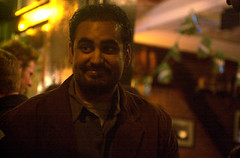Dai Sugano: The Forgotten People - Part II
I didn't want my own reflections to overshadow Dai's excellent work. So in an attempt to break up the focus, I've cut and pasted the second half of the post.
There is this school of thought in photojournalism, that in order to remain objective we must remove ourselves from the equation. The idea is that in order to get the most honest image we must be a fly on the wall. This, as photojournalist know, is the catch 22 of our profession. Just mearly being present changes the enviroment. The relationship of you and the interaction of those around you is different than if you weren't there at all, and introducing a camera exponitially rasies the effect.
Consider it in terms of a river. A river flows and rushes down with gravity. Throwing a photographer, or to illustrate the point a rock, into the mix changes things. Sure the rock is nothing compared to the might of a rushing river, but the rock is effecting the scene and the river is reacting to the rock. Water rushes around it, slows down approching it and speeds up on departure, any criters in the river will change course to avoid the rock. On the larger scale, the rock is negligable, but on the localized plain, it's becoming an active factor in the river flows dynamic.
In a similar way, photojournalist also change the scene on the smallest scales. It's a missconception to think anything else. Just our presence alone effects the scene.
What Dai has done with his project is tackle the issue head-on. He's accepted this hard fact and his project is better for it.
Ok... so I kind of went off on a tangent, but the point remains. Dai's project is a peice worth checking out for photojournalist and non-professionals alike. Go now!
There is this school of thought in photojournalism, that in order to remain objective we must remove ourselves from the equation. The idea is that in order to get the most honest image we must be a fly on the wall. This, as photojournalist know, is the catch 22 of our profession. Just mearly being present changes the enviroment. The relationship of you and the interaction of those around you is different than if you weren't there at all, and introducing a camera exponitially rasies the effect.
Consider it in terms of a river. A river flows and rushes down with gravity. Throwing a photographer, or to illustrate the point a rock, into the mix changes things. Sure the rock is nothing compared to the might of a rushing river, but the rock is effecting the scene and the river is reacting to the rock. Water rushes around it, slows down approching it and speeds up on departure, any criters in the river will change course to avoid the rock. On the larger scale, the rock is negligable, but on the localized plain, it's becoming an active factor in the river flows dynamic.
In a similar way, photojournalist also change the scene on the smallest scales. It's a missconception to think anything else. Just our presence alone effects the scene.
What Dai has done with his project is tackle the issue head-on. He's accepted this hard fact and his project is better for it.
Ok... so I kind of went off on a tangent, but the point remains. Dai's project is a peice worth checking out for photojournalist and non-professionals alike. Go now!








<< Home